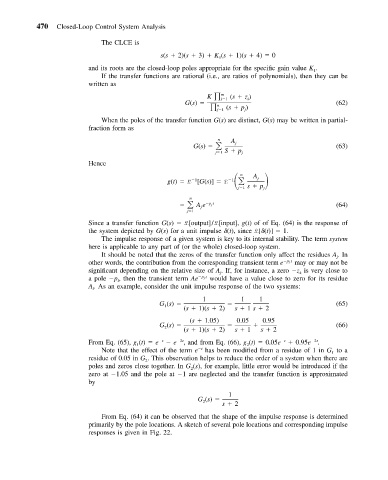Page 479 - Mechanical Engineers' Handbook (Volume 2)
P. 479
470 Closed-Loop Control System Analysis
The CLCE is
s(s 2)(s 3) K (s 1)(s 4) 0
1
and its roots are the closed-loop poles appropriate for the specific gain value K .
1
If the transfer functions are rational (i.e., are ratios of polynomials), then they can be
written as
m
K i 1 (s z )
i
G(s) n (62)
j 1 (s p )
j
When the poles of the transfer function G(s) are distinct, G(s) may be written in partial-
fraction form as
G(s) A j (63)
n
j 1 S p j
Hence
g(t) L [G(s)] L n A j
1
1
j 1 s p j
Ae pt j (64)
n
j 1 j
Since a transfer function G(s) L[output]/L[input], g(t) of of Eq. (64) is the response of
the system depicted by G(s) for a unit impulse (t), since L[ (t)] 1.
The impulse response of a given system is key to its internal stability. The term system
here is applicable to any part of (or the whole) closed-loop system.
It should be noted that the zeros of the transfer function only affect the residues A .In
j
other words, the contribution from the corresponding transient term e pt j may or may not be
significant depending on the relative size of A . If, for instance, a zero z is very close to
k
j
a pole p , then the transient term Ae pt j would have a value close to zero for its residue
l
A . As an example, consider the unit impulse response of the two systems:
l
1 1 1
G (s) (65)
1
(s 1)(s 2) s 1 s 2
(s 1.05) 0.05 0.95
G (s) (66)
2
(s 1)(s 2) s 1 s 2
(t) e t e 2t , and from Eq. (66), g (t) 0.05e t 0.95e 2t .
From Eq. (65), g 1 2
Note that the effect of the term e t has been modified from a residue of 1 in G to a
1
residue of 0.05 in G . This observation helps to reduce the order of a system when there are
2
poles and zeros close together. In G (s), for example, little error would be introduced if the
2
zero at 1.05 and the pole at 1 are neglected and the transfer function is approximated
by
1
G (s)
2
s 2
From Eq. (64) it can be observed that the shape of the impulse response is determined
primarily by the pole locations. A sketch of several pole locations and corresponding impulse
responses is given in Fig. 22.

